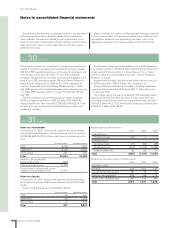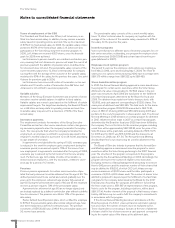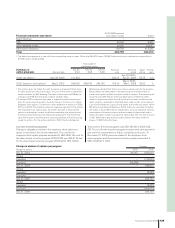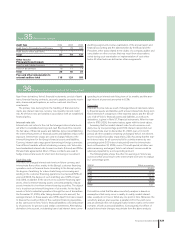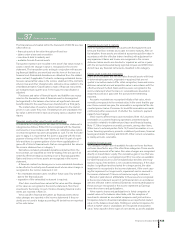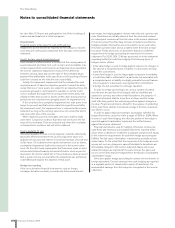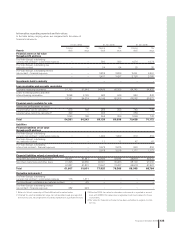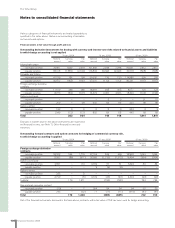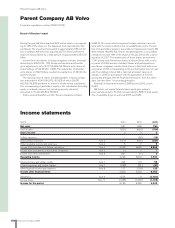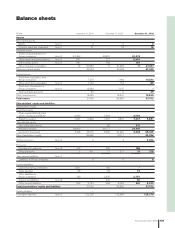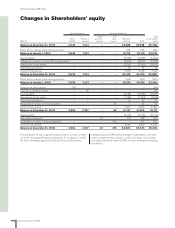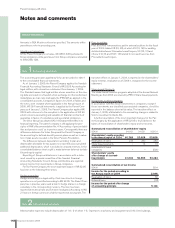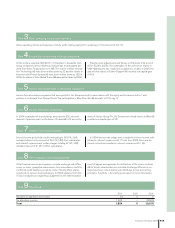Volvo 2006 Annual Report Download - page 138
Download and view the complete annual report
Please find page 138 of the 2006 Volvo annual report below. You can navigate through the pages in the report by either clicking on the pages listed below, or by using the keyword search tool below to find specific information within the annual report.
134 Financial information 2006
The Volvo Group
Notes to consolidated financial statements
for sale. Note 15 Shares and participations lists Volvo’s holdings of
shares and participations in listed companies.
Impairments
Financial assets at fair value through profi t and loss
Impairments do not need to be reported for this category of assets
since they are continuously revalued at their fair value in the income
statement.
Assets that are valued at amortized cost
Volvo conducts routine controls to ensure that the carrying value of
assets valued at amortized cost, such as loans and receivables, has
not decreased, which would result in an impairment loss reported in
the income statement. Impairments consist of the difference
between carrying value and current value of the estimated future
payment fl o w attributable to the specifi c asset. Discounting of future
cash fl o w is based on the effective rate used initially.
Initially, the impairment requirement shall be evaluated for each
respective asset. If, based on objective grounds, it cannot be deter-
mined that one or more assets are subject to an impairment loss, the
assets are grouped in units based, for example, on similar credit
risks to evaluate the impairment loss requirement collectively. Indi-
vidually written down assets or assets written down during previous
periods are not included when grouping assets for impairment test.
If the conditions for a completed impairment loss later prove to no
longer be present, and that can be related to a specifi c event after
the impairment event, the impairment loss is reversed in the income
statement as long as the carrying value does not exceed the amort-
ized cost at the time of the reversal.
When regard to accounts receivable, provisions shall be made
when there is objective evidence that Volvo will not receive the full
value of the receivable. They are excluded only when the receivable
is deemed to be worthless and will not be obtained.
Assets available for sale
If an asset available for sale is to be impaired, it shall be effected by
taking the difference between the asset’s acquisition value cost
(adjusted for any accrued interest if it involves that type of asset) and
its fair value. If it instead involves equity instruments such as shares,
a completed impairment shall not be reversed in the income state-
ment. On the other hand, impairments that have been made on debt
instruments (interest-bearing instruments) shall in whole or part be
reversed in the income statement, in those instances where an event
that is proven to have occurred after the impairment was performed
is identifi ed and impacts the valuation of that asset.
Hedge Accounting
Volvo uses derivative fi nancial instruments, such as foreign
exchange derivative contracts, forwards and futures and interest-
rate swaps, for hedging against interest-rate risks and currency-rate
risks. Derivatives are initially valued at their fair value and revalued
on subsequent occasions at their fair value in the income statement,
if it can be proven that they have not been included in an effective
hedging situation. Derivatives are accounted for as an asset when
they have a positive value and as a liability when they have a nega-
tive value. Profi ts and losses on derivatives that do not fulfi ll the
requirements for hedge accounting are reported in the income
statement. For 2006, SEK 10 M was accounted for in the statement
regarding ineffective cash fl ow hedging. The following types of
hedges can be utilized:
• A fair value hedge is used to hedge against exposure to changes in
fair value of a recognized asset or liability or a previously unrecog-
nized fi rm commitment.
• A cash fl ow hedge is used to hedge against exposure to variability
in cash fl o ws that is attributable to a particular risk associated with
a recognized asset or liability or a highly probable forecast transac-
tion in regards to a previously unrecognized fi r m commitment.
• A hedge of a net investment in a foreign operation.
In order for hedge accounting to be used, a number of criteria
must be met: the position to be hedged shall be identifi ed and
exposed to currency and interest rate fl u ctuations, the purpose of
the loan/instrument shall be to perform a hedge, and the hedge
shall effectively protect the underlying position against changes in
its value. Financial instruments utilized for the purpose of protecting
future cash fl ows shall be considered a hedge if the fl o w is deemed
very likely to occur.
In order to apply hedge accounting in accordance with IAS 39,
hedge effectiveness must be within a range of 80% to 125%. When
it comes to cash fl o w hedging, the effective portion of the hedge is
reported against shareholders’ equity and the ineffectiveness
against the income statement.
Financial instruments used for hedging of forecast commercial
cash-fl ows and electricity consumption have been reported at fair
value, which is debited or credited to a separate component of equity
to the extent the requirements for cash-fl ow hedge accounting are
fulfi lled. The fair value of derivatives is determined primarily by their
market value. To the extent that the requirements for hedge account-
ing are not met, any changes in value attributable to derivatives are
immediately charged to the income statement. Gains and losses
related to hedges are reported at the same time as the gains and
losses on the items that are hedged effect the Group’s consolidated
shareholders’ equity.
Volvo also applies hedge accounting for certain net investments in
foreign operations. Current earnings from such hedging are reported
in a separate portion of shareholders’ equity. At divestment, the
accumulated earnings from the hedge are recognized in the income
statement.




